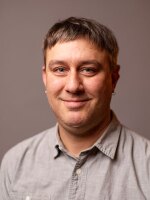Brian Charette has two new albums demonstrating very different sides of his modern explorations on the Hammond organ. The New York City star is making his Northwest debut this weekend, with concerts in Bellingham and Seattle. New Cool host Abe Beeson recently connected with Charette and got some insight on his unique, soulful style.
Consistently ranking near the top of the Downbeat Critic's Poll for organ players, Charette loves the classic funk style of his predecessors like Jimmy Smith and Jack McDuff. That said, he's also a lover of synthesizers, looping and creating beats on his drum machine. The resulting music is rooted in the soul tradition of the instrument, but with a 21st-century perspective.
Charette will employ Seattle rhythm-section talents Cole Schuster on guitar and Adam Kessler at the drums for his shows in Washington. The following weekend, Portland gets a double dose of "Vitamin B3" as Charette teams with McTuff at the Goodfoot Jan. 29 and 30. Schuster and drummer Ehssan Karimi have guided organist Joe Doria's third version of his trio to interesting, modern directions.
New Cool host Abe Beeson asked Charette about his diverse musical output, and the sources of his inspiration.
The New Cool: You were a teenager during the electro-pop and early hip-hop days in the '80s. Did that era influence your developing interest in music?
Brian Charette: Very much. To be honest, it's my favorite music. I'm also so interested in synths and drum machines. When I was young, I got to work with midi and synths in the early '80s at a place called Talcott Mountain Science Center, where I got to work with early music software and lots of great synths, so I've always been interested in adding these elements to my jazz music.
TNC: You've played in a variety of musical settings in your career. How has that affected the way you think about jazz?
BC: It's made me not think so much about labels. I'm interested in lots of different kinds of music and so are my bandmates. We try to bring all these different elements into our music when we play.
TNC: What finally drew you to the Hammond organ? Did you model your playing style on anyone in particular?
BC: Not really, but my first big influences were the rock guys: Keith Emerson, Jon Lord. When I started to play jazz more, I was very into Melvin Rhyne and Jimmy Smith.
TNC: On the new album Like the Sun, were you comfortable combining the "cold" digital keyboard and drum machine sounds with the "warm" Hammond organ?

BC: I loved the contrast. I also recorded that album during the height of the pandemic when everyone was in lockdown which gave me the opportunity to really work on my music with the machines. I started doing a livestream Tuesday nights that I still do that helped me hone the set. The songs on Like the Sun were live performances with all the machines, with just a few overdubs.
TNC: The horns on your sextet album Power in the Air are so powerful in unison. How did you create this sound combination?
BC: The sextet on Power was first conceived when I played in John Ellis' group, Double Wide. This is where I fell in love with the bass clarinet. I also loved wind ensemble music and wanted to combine this sound with organ. This was the genesis of Music for Organ Sextet.
TNC: A good example of this combination is on the song "As if to Say" from Power in the Air. How did this song come together — as you wrote it, arranged it, performed it?
BC: I wrote the piece with a flute and my computer, which is how all the pieces on Power were written. Arranging is pretty easy if you play a keyboard instrument; I would just blow out my chordal ideas for the wind section. We didn't even rehearse; we just tracked a few takes and one of those is what you hear on the album.
TNC: Both Like the Sun and Power in the Air were started before the pandemic lockdowns. Do you have plans for future recordings?
BC: Yes. I just recorded a new Hammond quartet last month at Rudy Van Gelder's studio for Vancouver's Cellar Live label with Cory Weeds, Ed Cherry and Bill Stewart. It's a very traditional organ quartet, which is something I haven't really done a lot of, and I thought it was time to do something super swinging and right down the middle. I've written all new tunes that are catchy and just a little bit adventurous, but very in the vein of all my favorite classic tracks.
TNC: You're often called a modernist or an unconventional musician. How would you describe 21st-century jazz?
BC: 21st-century jazz has all of the tradition of the last century with all of the modern sounds of electronics and world music. It's a great time to be a jazz musician. There are so many possibilities.
Catch the New Cool Friday night to hear a song from each of Charette's unique collections of modern Hammond organ possibilities, and don't miss our region's first chance to see Brian Charette in person. The trio performs at the Jazz Center of Bellingham Saturday night, and at Seattle's Royal Room Sunday night.








